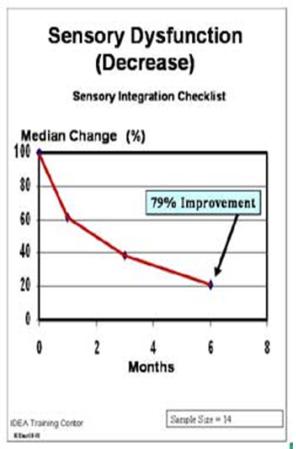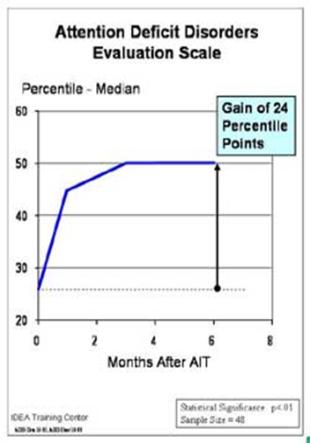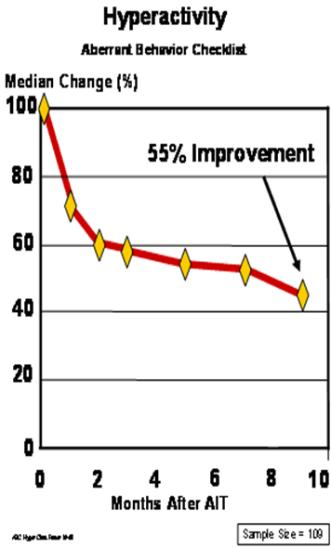감각기제에 대한 베라르AIT 효과
(Pilot Study Documents Impacts of AIT on Sensory System)
연구자: 베라르AIT국제학회(BAITIS)장, 미국의 Sally Brockett
미국의 Sally Brockett(2001)은 14명의 아동을 대상으로 베라르AIT 이전, 이후 1개월, 3개월, 6개월에 걸쳐서 베라르AIT의 효과여부와 정도를 알아보기 위하여 여러 가지 데이터를 측정하였습니다. 측정도구는 감각통합 기능, 주의력, 과잉행동 등을 포함하는 검사도구를 이용하였습니다. Sally가 14명의 아동을 대상으로 실시한 연구결과는 다음과 같습니다:
Berard AIT가 다양한 기능과 능력의 개선을 창출한다는 것은 수많은 연구와 임상적 관찰에서 나타났다. 다음의 연구결과는 Berard AIT 공인장치(Audiokinetron, Earducator)를 이용한 Berard AIT 방법의 결과이며, 다른 장치, 다른 방법이나 다른 종류의 음악을 이용하는 중재들(다른 AIT, 음악치료 등)에서는 동일한 결과(효과)가 나타날 수 없다(일반화될 수 없다).
① 감각통합:
2001년 Sally는 IDEA Training Center에서 다양한 진단을 받았으나, 모두 감각통합 문제가 있는 14명의 아동을 대상으로 AIT이전, AIT 이후 1개월, 3개월, 6개월에 전형적 감각통합 체크리스트 항목과 전정과민, 전정감각 과소, 촉각변별, 자기조절, 놀이상호작용을 포함하는 체크리스로 데이터를 측정하였다(6개월간 그래프 참조)
감각 역기능 감소: 79%감소, 치료 후 6개월까지 지속적 감소 추세

② 주의력 결함:
주의력결핍 평정척도(The Attention Deficit Disorders Evaluation Scale) 이용하여 데이터 측정하였다(그래프 참조).
주의력 증가: 24% 개선, 첫 3개월까지 빠른 개선

③ 과잉행동:
이상행동체크리스트(the Aberrant Behavior Checklist) 이용하여 데이터 측정하였다. 과잉행동이 AIT후 첫 1개월에 빠른 감소를 보인 이후 9개월까지 점진적으로 감소하였다(그래프 참조).
과잉행동 감소: 55% 개선, 첫 1개월에 빠른 감소 후, 9개월까지 지속적 감소.
 <?xml:namespace prefix = v ns = "urn:schemas-microsoft-com:vml" />
<?xml:namespace prefix = v ns = "urn:schemas-microsoft-com:vml" />
원문개요 보기 ↓
Pilot Study Documents Impacts of AIT on Sensory Systems
Brockett Sally(2001),
The Sound Connection, 2002, 9(3)
Berard AIT Produces Documented Results
Berard AIT creates improvements in a variety of skills and abilities. This is reflected in numerous studies and through clinical observations with our own clients.
The following data is based on proper use of the Berard method with Berard approved devices (either the Audiokinetron or the Earducator 6/F™.) These results can not be generalized to other types of sound-based interventions using different equipment, methods or music sources.
Sensory Integration
In 2001, Sally Brockett conducted a pilot study at IDEA Training Center with a group of 14 children with varied diagnoses, but all with identified sensory integration difficulties, to see if the anecdotal reports of sensory improvements could be quantified.
The children participated in a standard program of AIT. Parents completed a sensory checklist prior to AIT, and then at 1 month, 3 months and 6 months post-AIT.
The checklist contained items typically seen on sensory integration checklists and included areas such as vestibular hypersensitivity, vestibular hyposensitivity, tactile discrimination, self-regulation, play interactions etc.
The data on the adjacent chart indicates the changes that were measured through the 6 months period of monitoring progress.
Attention Deficit
The Attention Deficit Disorders Evaluation Scale was used to monitor progress with children who participated in AIT.
The adjacent chart depicts the average baseline percentile of this group prior to AIT.
Rapid improvement was seen in the first three months, with the median percentile reaching the 50th
percentile, a gain of 24 percentile points.
Half of the children achieved greater gains than this, and half of them did not achieve this much.
Hyperactivity
Data was collected on hyperactivity using the Aberrant Behavior Checklist to obtain a baseline and to monitor changes across time.
This chart shows a rapid improvement (decrease in hyperactivity) one month after AIT and shows progressive improvement through nine months post-AIT.
Half of the individuals showed even more improvement, including some in which hyperactivity was eliminated.









